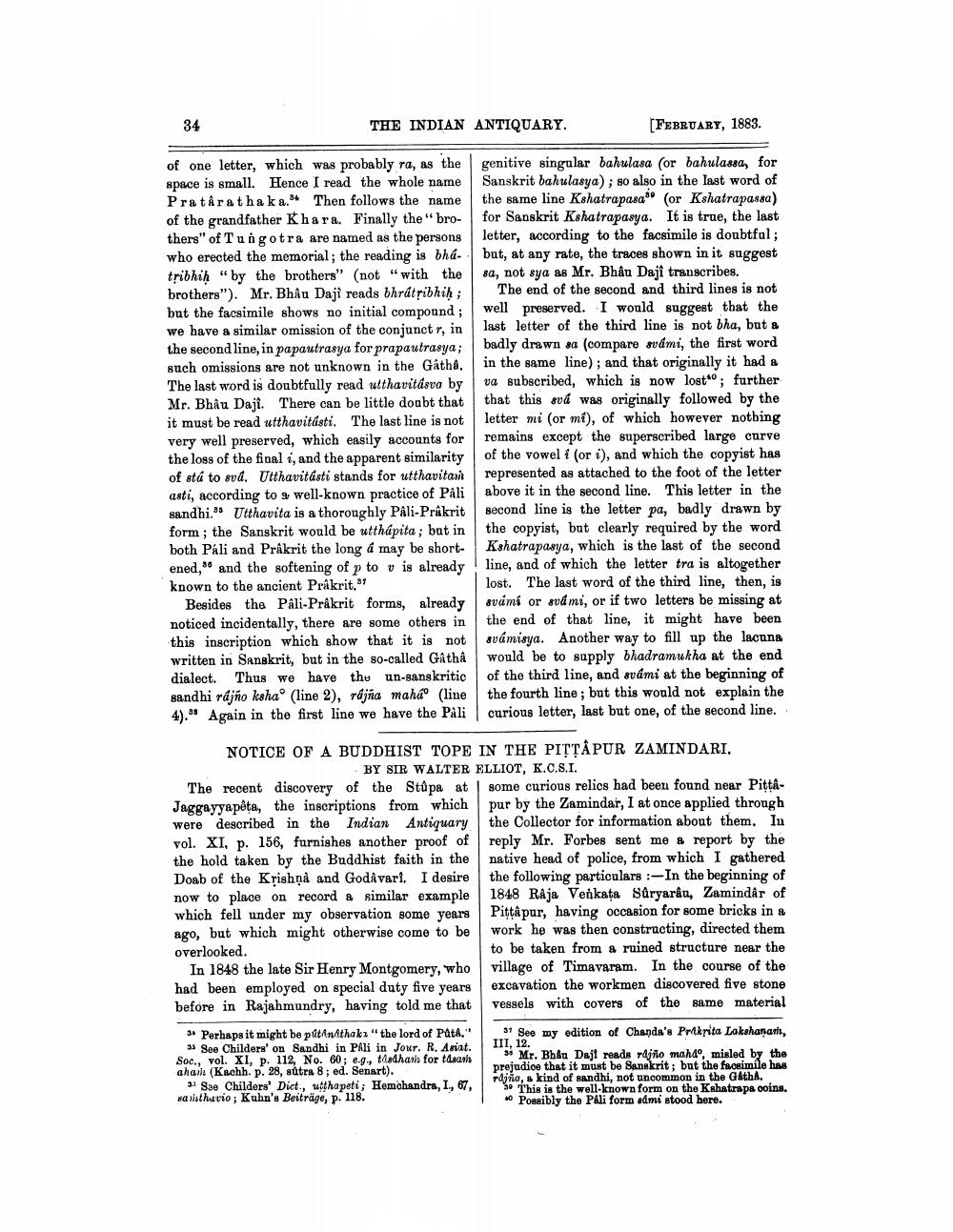________________
34
THE INDIAN ANTIQUARY.
[FEBRUARY, 1883.
of one letter, which was probably ra, as the genitive singular bahulasa (or bahulassa, for space is small. Hence I read the whole name Sanskrit bahulasya); so also in the last word of Pratâratha ka." Then follows the name the same line Kshatrapasa. (or Kshatrapassa) of the grandfather Khara. Finally the bro- for Sanskrit Kshatrapasya. It is true, the last thers" of Tungotra are named as the persons letter, according to the facsimile is doubtful; who erected the memorial; the reading is bhá- but, at any rate, the traces shown in it suggest tribhih "by the brothers" (not "with the sa, not sya as Mr. Bhâu Daji transcribes. brothers"). Mr. Bhâu Daji reads bhrátsibhih; The end of the second and third lines is not but the facsimile shows no initial compound; well preserved. I would suggest that the we have a similar omission of the conjunct r, in last letter of the third line is not bha, but a the second line, in papautrasya for prapautrasya; badly drawn sa (compare svami, the first word such omissions are not unknown in the Gatha. in the same line); and that originally it had a The last word is doubtfully read thavitásva by va subscribed, which is now lost"; further Mr. Bhâu Daji. There can be little doubt that
that this svá was originally followed by the it must be read utthavitásti. The last line is not letter mi (or mi), of which however nothing very well preserved, which easily accounts for remains except the superscribed large curve the loss of the final i, and the apparent similarity of the vowel i (or i), and which the copyist has of stá to svd. Utthavitásti stands for utthavitar represented as attached to the foot of the letter asti, according to a well-known practice of Páli above it in the second line. This letter in the sandhi.'' Utthavita is a thoroughly Pali-Prakrit second line is the letter pa, badly drawn by form; the Sanskrit would be utthápita; but in the copyist, but clearly required by the word both Páli and Prakrit the long á may be short- Kshatrapasya, which is the last of the second ened, and the softening of p to v is already line, and of which the letter tra is altogether known to the ancient Prakrit."
lost. The last word of the third line, then, is Besides the Påli-Prakrit forms, already svámi or svá mi, or if two letters be missing at noticed incidentally, there are some others in
the end of that line, it might have been this inscription which show that it is not svamisya. Another way to fill up the lacuna written in Sanskrit, but in the so-called Gatha would be to supply bhadramukha at the end dialect. Thus we have the an-sanskritic of the third line, and svámi at the beginning of sandhi rajño kshao (line 2), rajña maháo (line the fourth line ; but this would not explain the 4)." Again in the first line we have the PAlicurious letter, last but one of the second line.
NOTICE OF A BUDDHIST TOPE IN THE PITTAPUR ZAMINDARI.
BY SIR WALTER ELLIOT, K.C.S.I. The recent discovery of the Stupa at some curious relics had been found near PittaJaggayyapota, the inscriptions from which pur by the Zamindar, I at once applied through were described in the Indian Antiquary the Collector for information about them. In vol. XI, p. 156, furnishes another proof of reply Mr. Forbes sent me & report by the the hold taken by the Buddhist faith in the native head of police, from which I gathered Doab of the Krishna and Godavari. I desire the following particulars :- In the beginning of now to place on record a similar example 1848 RAja Venkata Suryaran, Zamindar of which fell under my observation some years Pittpur, having occasion for some bricks in a ago, but which might otherwise come to be work he was then constructing, directed them overlooked.
to be taken from a ruined structure near the In 1848 the late Sir Henry Montgomery, who village of Timavaram. In the course of the had been employed on special duty five years excavation the workmen discovered five stone before in Rajahmundry, having told me that vessels with covers of the same material
3. Perhaps it might be patAnAthaka "the lord of PatA." See my edition of Chanda's Prikrita Lakshanash, 35 See Childers' on Sandhi in Páli in Jour. R. Asiat.
III, 12. Soc., vol. XI, p. 112, No. 60; e.g, tisdharis for theamh
3 Mr. Bhdu Dajt reads rijño mahdo, misled by the ahale (Kachh. p. 28, sutra 8; ed. Senart).
prejudice that it must be Sanskrit; but the facsimile has
Tájfio, a kind of sandhi, not uncommon in the GthA. Sae Childers' Dict., utthapeti; Hemchandra, I., 67,
» This is the well-known form on the Kahatrapa coins. saisthuvio; Kuhn's Beiträge, p. 118.
1 Posibly the PAli form sami stood here.




